The following article was originally published by The Rambling Brick on September 29, 2016. It has been reprinted by permission of Richard Jones and The Rambling Brick.
Living with DiverCITY: changing depictions of gender roles with LEGO minifigures in the post-Friends era.
When I was a boy, and we rode dinosaurs to school, life was a little more simple than it is today. When the first LEGO mini figures were introduced, they were people. Not really men or women, just people. Their faces all looked the same: depicting the now classic smiley face. The only attempts to define gender, in terms of appearance, came in the form of the hair piece they had on if they were not wearing a hat! In that first year there were four ‘female’ mini figures released: they had hair with pigtails. If they were wearing a hat, you could quite happily identify that knight, policeman or astronaut as male or female as you should choose.

The designers have only attempted to define the gender of one of these minifigures.
Two of these ‘people with hair, defining their gender as female’ came as the only figure in their sets, along with vehicles: one an ambulance (606) and one a ‘Red Cross’ car(623). Another worked at the service station (376) and the final one came with a home (377). There was also a female passenger with a railway carriage. in 1979, the first classic ‘male’ minifigure hair appeared. In this first year, printed torsos were still a year or two away, and defining your minifigure’s identity came down to the sticker that you placed on the torso piece.
And then for more than 10 years of minifigure face design, nothing happened…however, some new torso prints appeared, featuring jewellery, but also torso prints defining suit jackets and other uniforms from male dominated professions.
As the pirates range was released in the late 80’s, gender identification in minifigure faces became a thing: stubble was introduced and the first specifically female minifigure head was released in the pirates range. The torso of this figure also featured a print defining feminine curves. The ‘male’ features: eye patches, stubble/ moutaches and beards were essentially printed over the standard smiley minifig face. The female face had pouty lips/lipstick, as well as partial hair print allowing her to have both a bandana and a visible fringe. It would be another year or two before other themes would extend the facial characteristics in any way.

With the introduction of facial prints, and torso prints depicting feminine curves, gender assignment of hat wearing minifigs was no longer solely the product of the child’s imagination.
As the 21st Century got underway, a definite skew developed in the marketing (always passively marketed as more of a boy toy) – the LEGO city type sets were more likely to be in a blue box, and the ratio of female to male mini figures in the line began to fall. Intellectual properties such as Star Wars had limited female characters taking part in the films, and so there was limited scope for female mini figures in these lines. Harry Potter took a step in a positive direction with around 25 of the 130 mini figures (Around nineteen percent) released over the life of the line depicting female characters. Eliminating the multiples – especially of Harry, Ron, Dumbledore but also Hermione – Twelve out of the fifty characters represented over the years of its run were female.
Recognizing that the bulk of their sales were to boys, in 2008, the company commenced a 4 year research cycle: focus groups, play testing, looking at the types of play that girls were more interested in. The outcome of this investigation was revealed in 2012 with the unveiling of the LEGO Friends line: Pastel colors (enriching the color palette for all); lifestyle roleplaying stories and a tie in story to prompt the direction of play.

Provoking controversy since 2012: LEGO Friends sets have certainly opened up a more engaging color palette
The settings have included school, home bedrooms/science labs/design studios, the veterinarian hospital, jungle camp, horse riding camp, the jungle, pop stars on tour and this year: an adventure camp, an observatory and amusement park sub-themes has been developed. It has also had the cake shop, hair dressers, beauty salon and shopping mall. The sets have not been without controversy provoking both positive and negative commentary, particularly with regard to the actual mini-dolls involved: slightly taller, multiple flesh tones and much slimmer than standard mini figures, with a more feminine shape. Also, some of the associated marketing material (such as in the LEGO Club magazine in some markets) have depicted activities for girls including makeovers and manicures. Other lines over the years, such as Belville and Scala, as well as the original HomeMaker figures from the mid 70’s have come and gone, but none seem to have had the impact on the overall LEGO zeitgeist as the Friends have had. Certainly, with more than two hundred and fifty sets produced since 2012, the theme continues to go from strength to strength.
These sets certainly have their detractors, but I am aware of many people who look at them predominantly for the benefits they have brought to the extended color palette. In 2015 the mini-dolls expanded into the Elves range, providing a greater fantasy based story line. Diversity in the friends line is also criticized – in the opposite direction to minifigures – with 14 out of 150 mini-dolls being depicted as male. Indeed, as a counter to the blue collar of the LEGO City boxes, the LEGO Friends sets tend to be in a purple or pink shade (or is it medium lavender) around the edges of the box art. However, looking closer, and excluding figures of the same character (i.e. call the 19 versions of Andrea that have appeared to date, one character’) and the ratio improves to 31 specific female to 10 male characters , i.e. just under one quarter of the characters depicted are male
Here’s an Idea
The Research Institute (21110) was released in 2014, as a result of the Ideas submission that reached its goal of 10000 supporters in June 2013, and then entered the review process prior to release a year later. Reviewing the project on LEGO Ideas shows that as well as the vignettes ultimately released, the designer Alatariel also proposed a number of other ideas. Some of these suggestions have come to pass in modified forms through Collectable Minifigures, the LEGO Movie and as characters in the LEGO City range.
Amongst other news in 2014, a letter from a seven year old girl named Charlotte was posted online, asking LEGO to explain the lack of adventures that her female mini figures were having, compared to the male ones. This letter went viral, and the LEGO’s response to the female mini figures on offer at the time was released shortly after.
How have things progressed in the LEGO City since since the early parts of this decade?
I have looked at all of the mini figures featured in the LEGO City range, across sub themes since 2011. In an attempt to define gender, I have looked at the stereotypical facial features used, as well as cues from clothing – specifically jewelry, feminine design/fashion to define the depiction of a mini figure’s gender as male/female or indeterminate/ at the discretion of the person playing with it. In 2016, the lego online store has started to define the gender of some characters (a male and female fireman, a female scientist and so on). I have not taken this description to heart in the presence of poorly defined gender characteristics.
So: how have things shaped up since 2011?
I referred to Brickset.com’s database of LEGO City sets released (as opposed to the specific mini figures released), on a yearly basis. I allocated characters a gender based on the characteristics considered above. Here is an example of how I categorized mini figure’s gender:
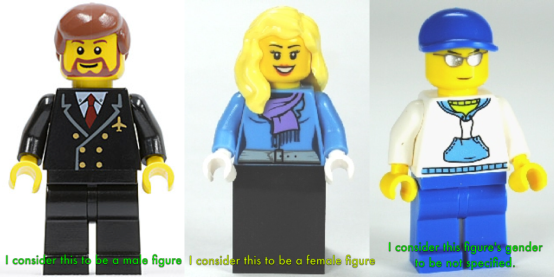
However, sometimes the answers are not so obvious: in the absence of a gender defining face or torso, I left the figures ‘not specified:

I left these figures without specifying their gender.
I categorized the sets according to sub theme, and totaled up the number of figures in each set according to figures that could be clearly defined as male or female, as well as those for whom defining characteristics were absent: like that first generation of mini figures. It became complicated with a number of faces and hair styles, but it became apparent that some hairpieces are used across genders within the LEGO City minifigures. I have presented the data as a commentary on notable points of the year, and as bar graphs, showing a representation of the overall gender breakdown for each year’s mini figures.
YEAR by YEAR
2011
LEGO City in 2011 had a mixture of the evergreen Police theme, a new train, a line of space exploration sets and a bayside ‘marina’/ harbor theme. This year, overall, the majority of figures are not of any specified gender. However, only six of the sixty one mini figures released in the CITY range are female ( a little over 9%). The majority of the figures in the space line were of non specific gender, but only one was female. Likewise, in the harbor theme, there were 2 women out of 13 figures, but only 4 were definitely male. These were slightly higher numbers than in the rest of the range. As an absolute count, here is how the definite gender distribution in the CITY line was distributed: Six out of sixty four figures released this year are women, but over half of the figures do not have their gender specified. Lets see how this spread plays out over future years:
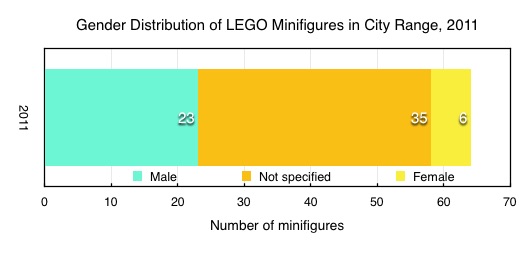 2012
2012
This year saw the debut of Forest Police: with only one specifically female figure out of twenty six in the range. The mining subtheme had eleven minifigures across the range, with no clearly defined women (but who would you expect to wear lipstick down a mine anyway) and four figures whose gender is not specified. A medical subtheme saw two out of 7 figures definitely female, with another 2 not specified, including pilots. The ‘traffic subtheme’ is a lot more evenly split: Five women, six men and eleven not specified. This means that slightly less than 25% of figures in a subtheme actively defined as female.
At the end of the year, there is a higher proportion of female figures than in the previous year, but there is still some way to go, towards a significant depiction of feminine characters.
 2013
2013
2013 sees the Police ‘Undercover’, Fire, Cargo and Coast Guard subthemes. I am finding some hard choices in the male or androgynous as well this year, more than previously. Although it is a typically male hair design, the faces are extremely generic and can be called either way if you wish. Here are some of the ones that challenged me a bit: Let me know what you think – have I been a bit gentle on allocation here. Certainly the two on the left are fairly indeterminate in facial characteristics. The policeman: I am considering the line under the chin to be a crease rather than a tiny growth of facial hair. The fireman – I have considered this face to be nonspecific, because changing the hair and clothes, it can work as either a male or female character.

I didn’t define these figures to any specific gender, as I believe the heads and torsos can be used in a more generic ways. But many will probably see them as having predominantly masculine characteristics. You are welcome to disagree.
However, in the Fire (#850618) and Police (#850617) Minifigure sets, both of these figures are defined in marketing material as male. Perhaps I am being overly generous as far as what I consider to be ‘not depicting strong male characteristics.’ But I think that is okay. If a figure is not clearly male or female, it is up to the audience to define it at the time they are playing with it. Overall, the male fraction is up slightly on the year before.

Another issue to be had with some of the sets from this year is that in 2 sets, the female characters are defined in a ‘damsel in distress’ scenario: in one, she is has called the fire department to get a cat out of the tree (having failed to lure it down with a fish. In the other, she is driving a car which has broken down and requires the tow truck to rescue her. In both sets it is hard to exchange the gender roles.
2014: Into the ice
This year, the Arctic sub theme theme is released, and there are an increased proportion of female figures as a fraction of the overall number of characters. There are also a number of characters defined in the Brickset database as Male research scientist, where the actual figure has no beard or stubble (actually unusual for men working in this environment! I has considered these characters to having their gender ‘not specified.’ Like wise, the research assistant can quite easily be considered to have their gender easily chosen by the person playing with them. As such, clearly defined women make up five of the twenty seven characters released across the theme. The pilot remains a question to me: in some sets, it is clearly a male figure – with stubble, no sunglasses; but in some sets it has sunglasses, no struggle and is not clearly defined. Is this the same pilot as the storyline progresses across sets, or is it a different pilot for the helicopter, helicrane and aeroplane? As such I have categorized the figure on the basis of how it is presented, not making any presumptions re: the storyline.

Is this the same character spread out across the arctic storyline, or a different person each time? You be the judge
Also, this year is the first time that one of the crooks in the Police sub-theme has been defined as female. In recent years, crooks have always had their gender defined. Almost always they have had some form of facial hair – be it a sophisticated moustache for the cat burglar – or a three day growth and a couple of missing teeth for one of the more hardened criminals.
Overall, 2014 saw a little over 13% of mini figures in the CITY line being defined as female. The Arctic sub theme, with characters taking part in scientific investigation features, almost 20% of the characters are female, with a high proportion of characters with a non specified gender. Unusual in an environment where the majority of men working are inclined to grow a beard.
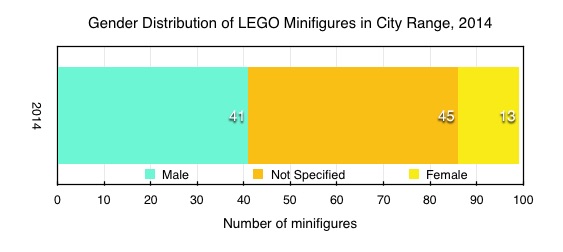 2015: Representation increases.
2015: Representation increases.
In 2015, there was a significant jump in the number of minifigures defined as women: thirty one out of one hundred and twenty eight – 24% Almost one quarter of figures were clearly women, and the level of ambiguity in the figures with non specified gender seemed to be a little higher than usual – that is to say it seemed as though I was saying ‘ I can’t really tell’ more often than I was saying ‘It’s probably meant to be a man or boy’.

Also of interest in 2015 was the presence of two sub themes representing adventure, exploration and scientific exploration: Deep Sea and Spaceport. Both of these sub themes had relatively higher female representation of clearly female minifigures: seven out of twenty two (Deep sea – 32%) and five out of fifteen (spaceport – 33%) Seven of these figures in Spaceport were not of a clearly specified gender by my definitions, however others may suggest that the astronaut without lipstick is probably intended to be male. Indeed the brickiest minifigure database lists this astronaut as male, but I feel that it could easily be interpreted more as a ‘person’ than male or female.
2016: The gap closes, but does the marketing department shoot itself in the foot??
This year, the marketing material has changed. In the set descriptions, there has been an increased rate of description of mini figures as being male or female, but also with some characters having more generic descriptions (‘a scientist in a volcano suit’). Forty one of one hundred and forty four mini figures released in the 2016 sets are clearly female. That is a little over 28%. This is the best representation of female characters in any LEGO City to date. And the women are mechanics, stunt pilots and fire fighters. They are scientists and explorers working on volcanoes. They are criminals and police. In a number of the Volcano sets, female characters outnumber the clearly male figures. In fact, in this theme, ten figures are clearly female out of a total of twenty seven. That is MORE THAN ONE THIRD!!).
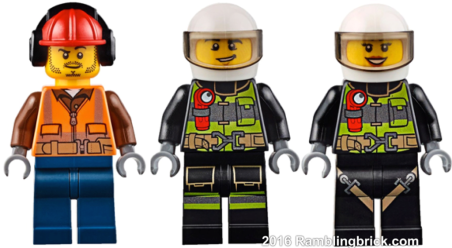
These three figures come in one of the 2016 City Fire sets: 60108 Fire Response Unit. One seems to be clearly depicted as male, one as female and the other is smiling.
One of the landmark sets in the city range this year is 60134: Fun in the Park. With fifteen minifgures, it contains 7 women, seven men and one baby. The characters are represented across a range of ages, and some of the women are shown in non traditional women’s roles on the box art: painting and grounds maintenance. This set also showed the first LEGO City character in a wheelchair.
With almost a third of figures being female, I am sure others will disagree with my interpretation of the gender of some characters, particularly those I have included in ‘non-specified’ group.
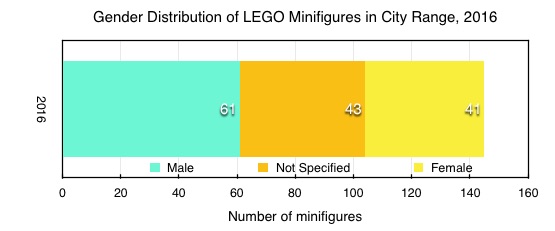
One of the lowlights, however, comes in the print catalog. While LEGO City has no specific gender marketing, the catalog clearly labels the LEGO Friends sets as ‘especially for girls’. While in part it says “We have LEGO for you young lady”, does it also passively say “Just not the really cool stuff with the motors and the robots?”
Where to from here?
So 2016 is perhaps represents the high water mark in the representation of women in the LEGO City theme to date.
It seems likely to me that over the next few years the number of figures that are defined as female, in the CITY line is likely to approach one third, with one third clearly male and around one third not clearly specified: allowing the audience to decide who is who.
But what of other themes: it would seem likely that Space and Castle type themes, both currently occupied by the NEXO Knights theme are unlikely to reach such a high level of female representation soon, but I suspect it will occur over time, as the characters develop in the series.
Licensed themes will depend in part on the source material. That said, there are more female heroes in the Batman (and entire DC universe) universe that we are yet to see in LEGO minifigure form. In Gotham city alone, we have Batgirl, but what of Spoiler, Batwoman and Huntress. Batman has more women in his life than just the femme fatales of Gotham city.

Previews of box art for 2017 have shown a sample of the characters to be found in LEGO City sets, and there is obviously more masculine man, one more feminine woman, and one who is not specified on the basis of what is seen. Now if only the boxes could stop being blue.
What about the LEGO Group?
As a company, the direction of product being delivered to the market place will be dependent in part on the leadership within the company.
There is a clear policy for setting goals on the employment and the advancement of gender diversity within the LEGO Group. In the 2015 ‘LEGO Group responsibilities report,’ progress in corporate diversity and engagement of women amongst new recruits, as well as leadership roles is highlighted:
Gender-balanced leadership
Our ambition is to have a balanced composition of genders by 2032 at all organisational levels. Our starting point is to ensure a gender-balanced flow of talent to deliver on this ambition.
In 2015, we achieved this by having 43% females among all newly appointed and recruited leaders. This is a significant improvement from 2011, where 23%of all newly appointed and recruited leaders were females.Our Gender Diversity Policy guides these actions and it stipulates that we always hire the most suitable and competent person for any job.
In conclusion
Charlotte is now likely to be around ten or eleven years old. There are now many women taking part in adventures in LEGO City – keeping the population safe, exploring the world, raising families, committing crimes, and performing death defying stunts at the airshow. I wonder if she kept up with her LEGO, and has noticed the difference now compared with 2014?
I recognise that marketing LEGO sets has the primary aim of selling more sets, to more people. As long as LEGO Friends is produced in a pink or lavender box, and has the words ‘especially for girls’ in the printed catalogue there will be a perception that by default, the rest of LEGO is for boys.
Don’t let it be so.
Look for sets with strong female characters – in fact within LEGO city this year, it is hard not to find them! Buy your daughters, nieces and other friends Mindstorms, Technic and encourage their imaginations to take them wherever they want to go. Visit LEGO Ideas and support projects such as Women in NASA, which just reached its 10000 supported recently. In conjunction with Ideas projects such as the Research institute 21110. It has never been easier to populate your LEGO town with an even gender balance.
I have not intended to be controversial with this post: merely to show where LEGO City has come over the last few years. As a toy to provoke the imagination, LEGO can be magical. But to do so, we need to be able to allow our imagination to flourish and not be told ‘This is a Man, this is a Woman.’
We are all People.
Play well.
*Images in this article have been sourced from brickset.com and brick link.com



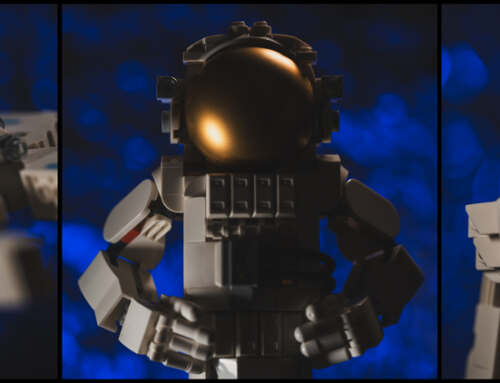
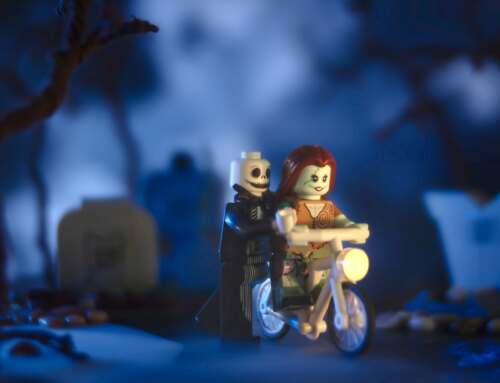
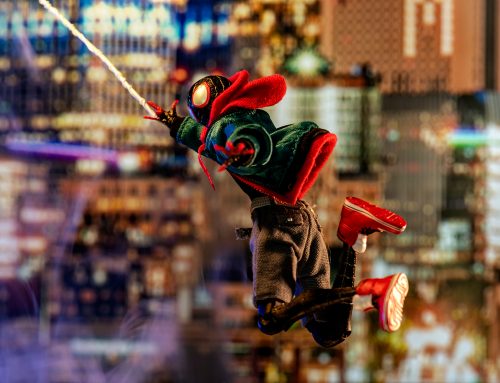
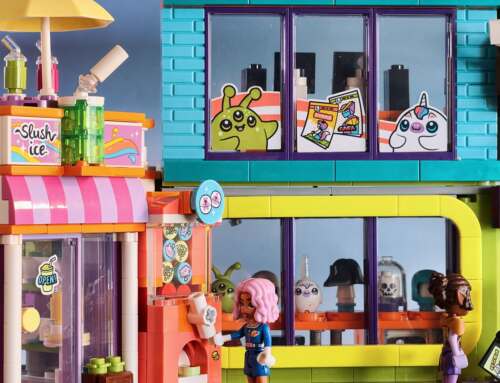
Whoa. What a well researched and impressive article. Thank you for this.